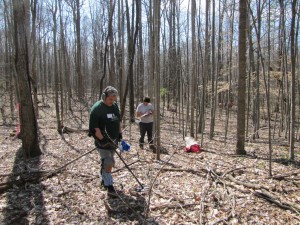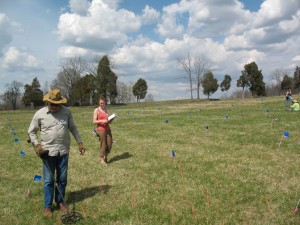Toward a Dynamic—and Virtual—Public Archaeology
In my mind, public archaeology involves reaching out and interacting with different audiences, ranging from…
 In March 2012, 12 metal detectorists were invited to James Madison’s Montpelier to attend a week-long metal detecting program to learn how archaeologists and the metal detector community can work together to more proactively to preserve sites. In the past, archaeologists and metal detectorists have worked together to make discoveries at battlefields and other historic sites such as the work conducted by Doug Scott at the Little Bighorn and at Manassas National Battlefield under my direction. We entered into this program with a full understanding of how metal detectorists can be employed for archaeological research on historic sites. The goal for this public-outreach program was to establish a rigorous curriculum in which the goals of site sustainability were laid out and metal detectorists were actively engaged and educated about this process. As such, we taught metal detectorists much more than just how metal detectors can be carefully used to recover artifacts at sites, but the why behind the rigorous methodology employed in this process. At the end of the week, we had a dozen metal detectorists who not only understood how site integrity can be attained through the use of metal detectors, but they were devising new techniques for how this process could be improved. In short, they gained an appreciation for archaeology, and the discipline of archaeology gained a new set of allies for what archaeology can offer in regard to discovering history.
In March 2012, 12 metal detectorists were invited to James Madison’s Montpelier to attend a week-long metal detecting program to learn how archaeologists and the metal detector community can work together to more proactively to preserve sites. In the past, archaeologists and metal detectorists have worked together to make discoveries at battlefields and other historic sites such as the work conducted by Doug Scott at the Little Bighorn and at Manassas National Battlefield under my direction. We entered into this program with a full understanding of how metal detectorists can be employed for archaeological research on historic sites. The goal for this public-outreach program was to establish a rigorous curriculum in which the goals of site sustainability were laid out and metal detectorists were actively engaged and educated about this process. As such, we taught metal detectorists much more than just how metal detectors can be carefully used to recover artifacts at sites, but the why behind the rigorous methodology employed in this process. At the end of the week, we had a dozen metal detectorists who not only understood how site integrity can be attained through the use of metal detectors, but they were devising new techniques for how this process could be improved. In short, they gained an appreciation for archaeology, and the discipline of archaeology gained a new set of allies for what archaeology can offer in regard to discovering history.
 An important aspect of this program was all 12 participants were metal detector dealers. As dealers, all participants are respected leaders from across the country who are linked into a network of metal detectorists. Bringing them to a better understanding of the shared goals and values between archaeologists and metal detectorists secures a foothold into the much larger hobby community. What discussions with these dealers revealed was that interest in metal detecting is growing, not shrinking. They all agreed that designing programs that give detectorists an entry into archaeology was essential for a more productive interaction between the two groups. As such, we designed this week-long program as a pilot project to see how this interaction could take place. Instrumental in organizing this group of dealers was Minelab Americas, a leading developer of metal detector technology. Minelab has been involved in several organized efforts to join archaeologists with the metal detector community for public outreach and education.
An important aspect of this program was all 12 participants were metal detector dealers. As dealers, all participants are respected leaders from across the country who are linked into a network of metal detectorists. Bringing them to a better understanding of the shared goals and values between archaeologists and metal detectorists secures a foothold into the much larger hobby community. What discussions with these dealers revealed was that interest in metal detecting is growing, not shrinking. They all agreed that designing programs that give detectorists an entry into archaeology was essential for a more productive interaction between the two groups. As such, we designed this week-long program as a pilot project to see how this interaction could take place. Instrumental in organizing this group of dealers was Minelab Americas, a leading developer of metal detector technology. Minelab has been involved in several organized efforts to join archaeologists with the metal detector community for public outreach and education.

Participant Ron DeGhetto scans the ground for metal artifacts while staff archaeologist Matt Greer records historic artifacts uncovered in the woods survey.
During this week-long program, metal detector enthusiasts worked side-by-side with archaeologists in discovering sites and recovering information to aid in the interpretation of sites. All the while, detectorists were trained through lectures, readings, and practical exercises on how the systematic use of metal detectors can aide in site preservation. Lectures were carefully tailored to reinforce concepts that metal detectorists would encounter during the hands-on exercises in the field. The evidence for metal detectorists engaging with archaeological concepts was evident in field exercises—metal detector participants used the utmost caution in excavating hits and quickly understood the concept of using a grid to record metal detector finds. In turn, archaeologists experienced how to work with detectorists in a team environment that fostered learning, preservation, and the thrill of discovery. The fieldwork was where these seasoned detectorists saw archaeology providing a whole new approach towards the discovery of historic artifacts.

Metal detector participant Ransom Hundley marking metal detector hits while staff archaeologists Kira Runkle records number of hits per square at the quarter for field slaves.
In the course of the week’s program, the detectorists were exposed to two very different use of metal detectors—the first for site discovery and the second for defining a site. Site discovery took place in wooded portions of the property that had never been systematically surveyed. By gridding the woods into 20 meter squares, each area was carefully scanned with detectors and artifacts sampled. Metal targets were excavated based on protocols such as depth, density, and signal strength. In this survey, archaeologists depended on detectorists’ expertise on reading signals while detectorists communicated the characteristics of the hits to allow archaeologists to determine how to sample. This process allowed some 20 acres to be surveyed in two days, and three sites (two early 19th century slave quarters and one barn/work area) were discovered. In addition, archaeologists and detectorists were able to determine which areas were potentially plowed in the early 19th century based on horse shoes and plow parts.
In the second portion of the program, a known site in an open field was gridded off into 10 foot squares and all signals in each square were marked with skewer sticks. Densities across the site were plotted in this manner and then selective squares were sampled to determine the historic context for the concentrations. In the process, three clusters of hits were deciphered across a 300 ft x 300 ft area that suggested the presence of several house areas within this early 19th century slave settlement. In this exercise, as in the woods, metal detectorists were quick to understand the value of the machine as both a non-invasive remote sensing device and as a tool to quickly locate and define hits that could be sampled without disturbing deep stratigraphy.
Throughout the week, both detectorists and archaeologists attended lectures geared towards demystifying the rationale behind field techniques employed during the week’s surveys. Topics such as recovery of information from features was combined with how signal depth could be used to avoid damage to features during survey and how recovery of a wide array of artifacts (including the ubiquitous nail) could aid in the interpretation of sites. Throughout the lectures, emphasis was placed on how metal detecting can actually enhance archaeologists’ ability to preserve site integrity. Participants walked away with not only a better understanding of how particular archaeological methods can benefit from metal detector surveys of a site, but also how care in recovery during metal detecting could enhance the enjoyment of the hobby. Both groups exchanged information on sets of artifacts that were important to each others’ discipline—archaeologists learned more about specific functions of diagnostic metal items in our collection, and metal detectorists came away with a better understanding of the variety and range of nails found at sites. Throughout the process, open dialogue was the main means of sharing information between the two groups—something that does not often happen between archaeologists and metal detectorists. This dialogue allowed us to share with participants how our methods led to data preservation both during survey and excavation of sites.
In the end, the goal of the program was to foster a mutual respect between the staff archaeologists and the metal detector participants. This goal was met through camaraderie built from shared discoveries, learning, and hard work. Metal detectorists left the program with the prospect of seeing how their hobby could be extended into the realm of archaeology, and archaeologists left with an understanding of how the knowledge base and skills held within the metal detecting community could be used for site survey. Telling were the exchanges of gifts between the groups—archaeologists providing metal detectorists with trowels, and metal detectorists bestowing pin pointers (electronic devices used to pinpoint the location of metallic objects in a small hole). The exchange of information, techniques, technology, and skills allowed for open discussion of views that each held of the other and a better sense of common ground between the two groups.
Proof for the success of this outreach program came both during and in the days following the program. Discussion forums featured detectorists writing in about the program, twitter pages were active with questions regarding the program, and several blogs featured the highlights of the expedition. In the days following the program, several dealers featured the highlights of their interaction on their company webpages, with one even donating a percentage of his monthly profits to furthering the preservation of archaeological sites at Montpelier, a donation that will be matched by Minelab Americas. Metal detector participants were encouraged to use the program as an entry point for contacting local archaeologists in their region to offer their services for identification and definition of sites. By learning a common language that archaeologists would understand (gridded systematic survey, sampling, mapping) we hope that these participants will be better able to make contact with archaeologists to offer their services. We hope that this exchange can continue and foster more discussions concerning our common goals to preserve sites and discover information about the past.
Have you, as an archaeologist, used metal detector technology in your survey work? Have you worked with metal detector enthusiasts in conducting these surveys? If so, what types of engagement have you used? What were some of the challenges you faced in establishing such programs, or what hurdles are keeping you from establishing one now?
Interested in developing your own training course? Dr. Reeves has made the Information Packet from his project available online. You can also see the video below that discusses Montpelier’s longtime relationship with metal detector technician, Lance Crosby.
SUNY Potsdam students do a field school here, correct?
Using metal detector technology? LOL He said it like it’s a new thing.